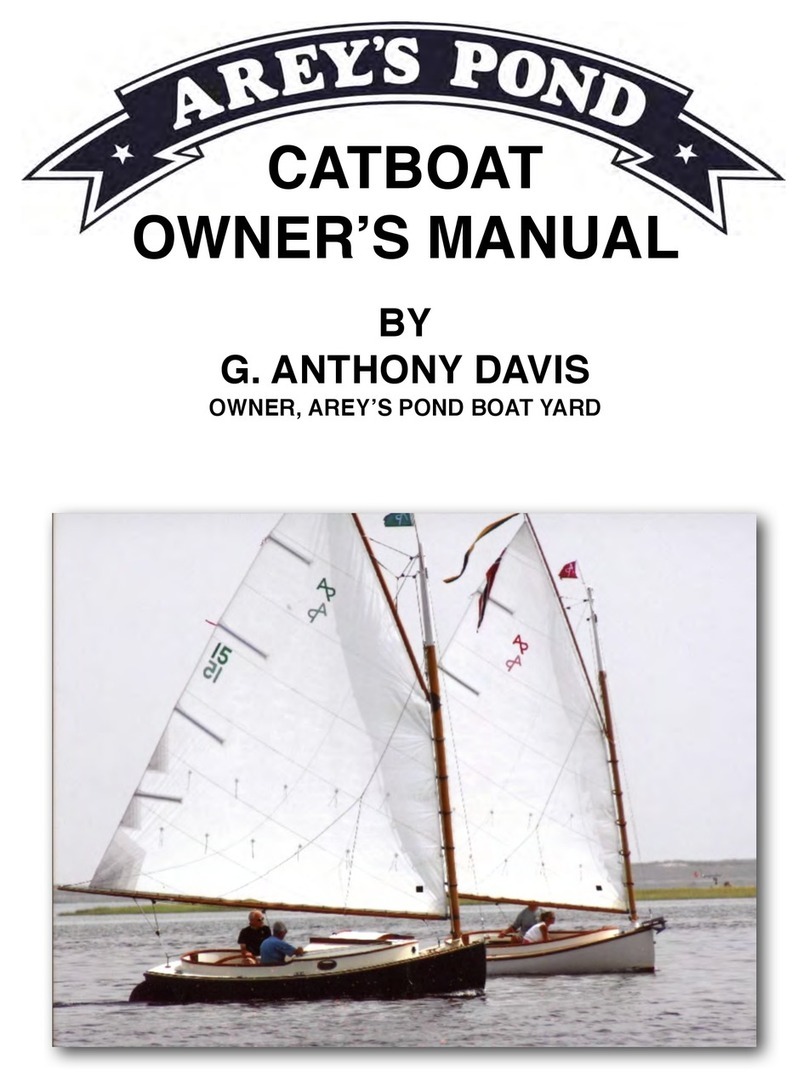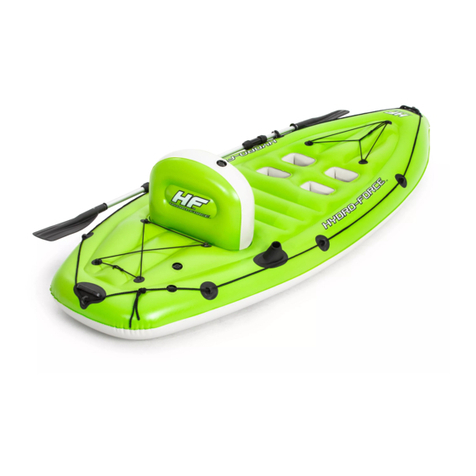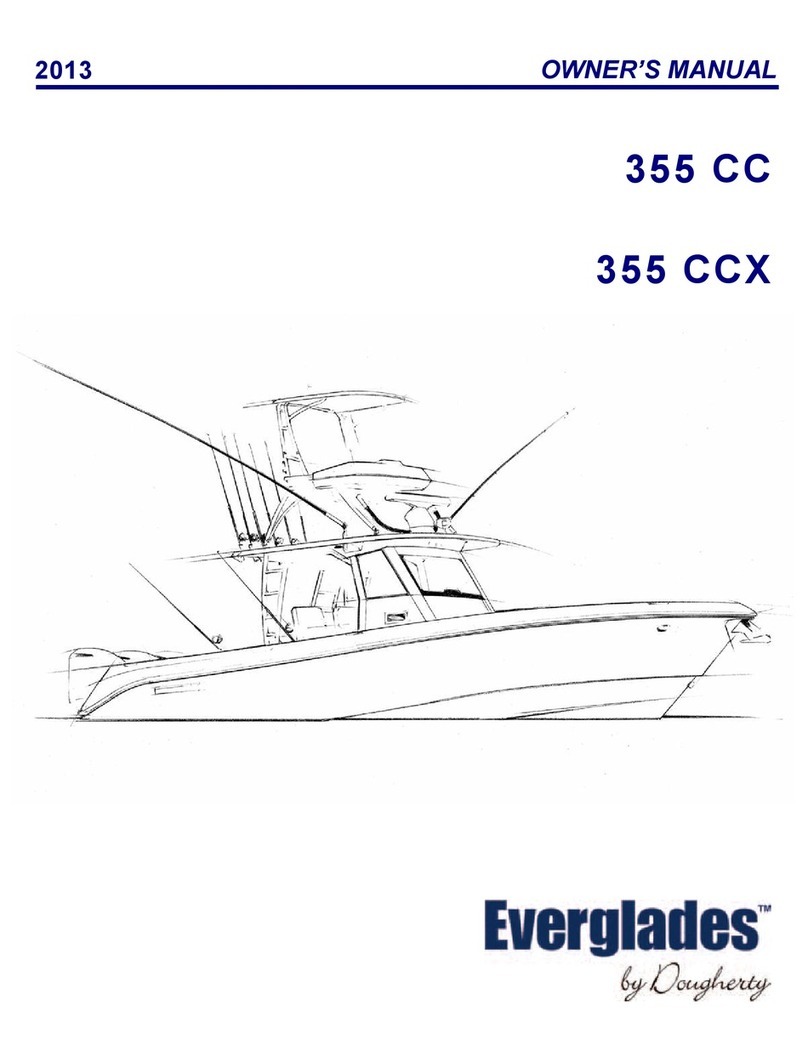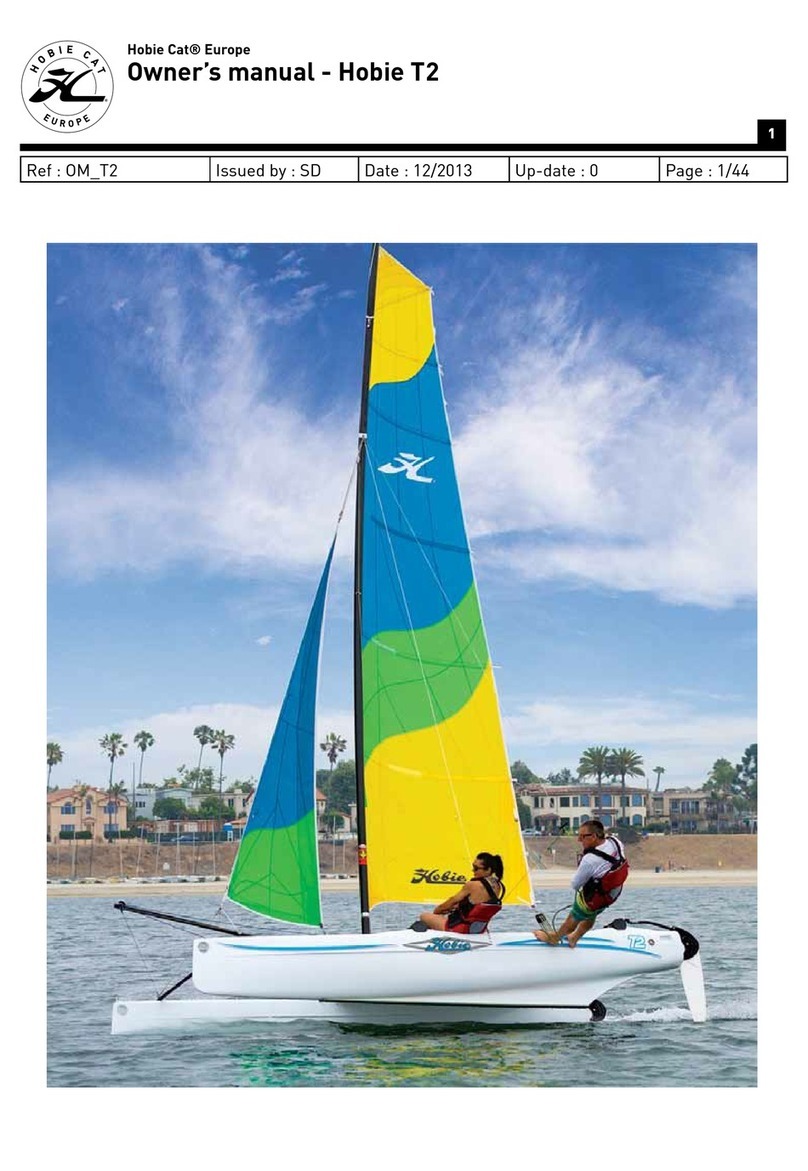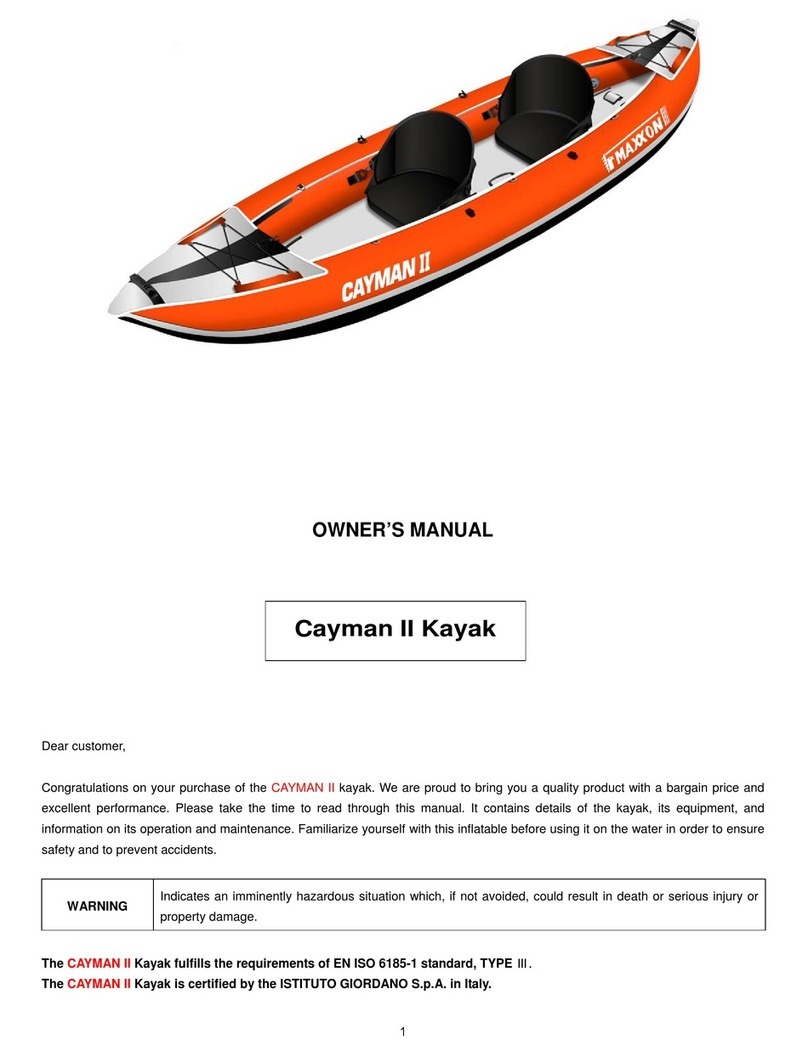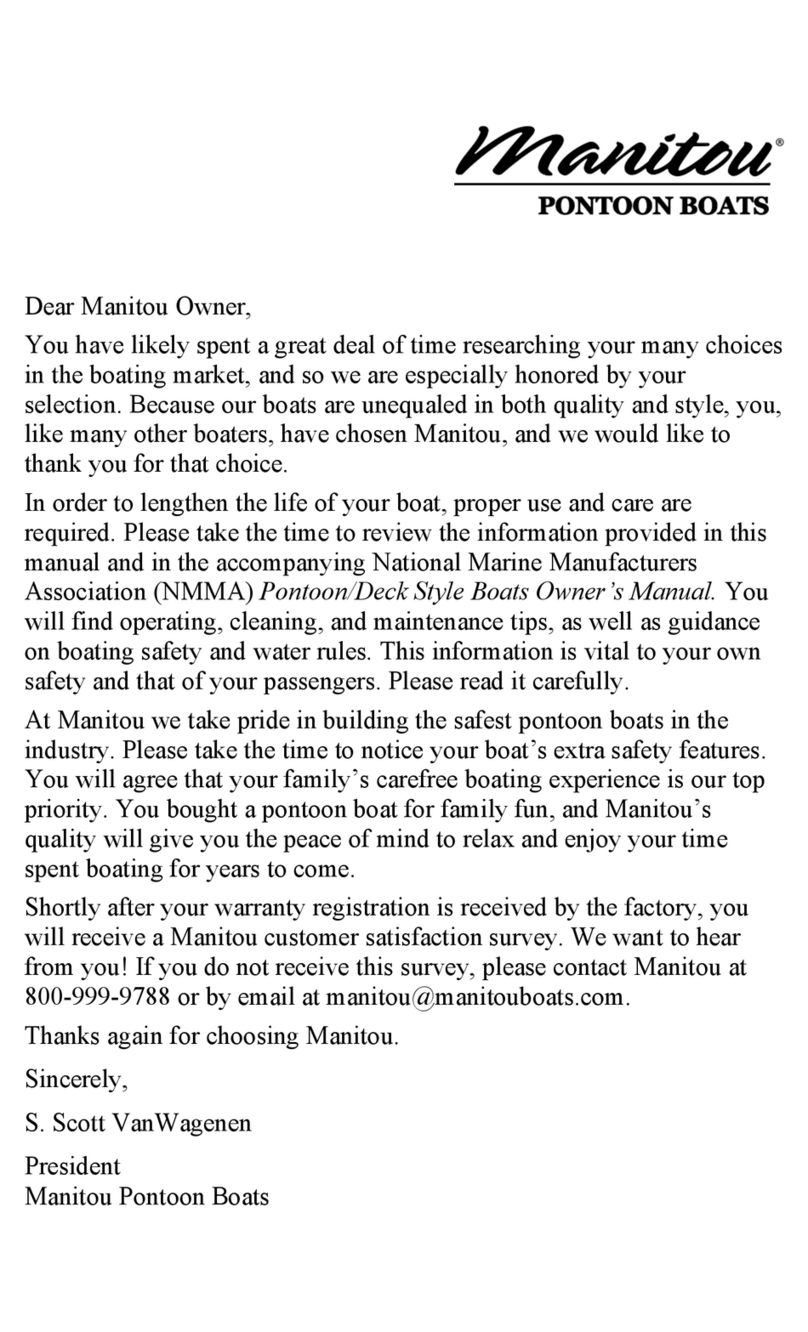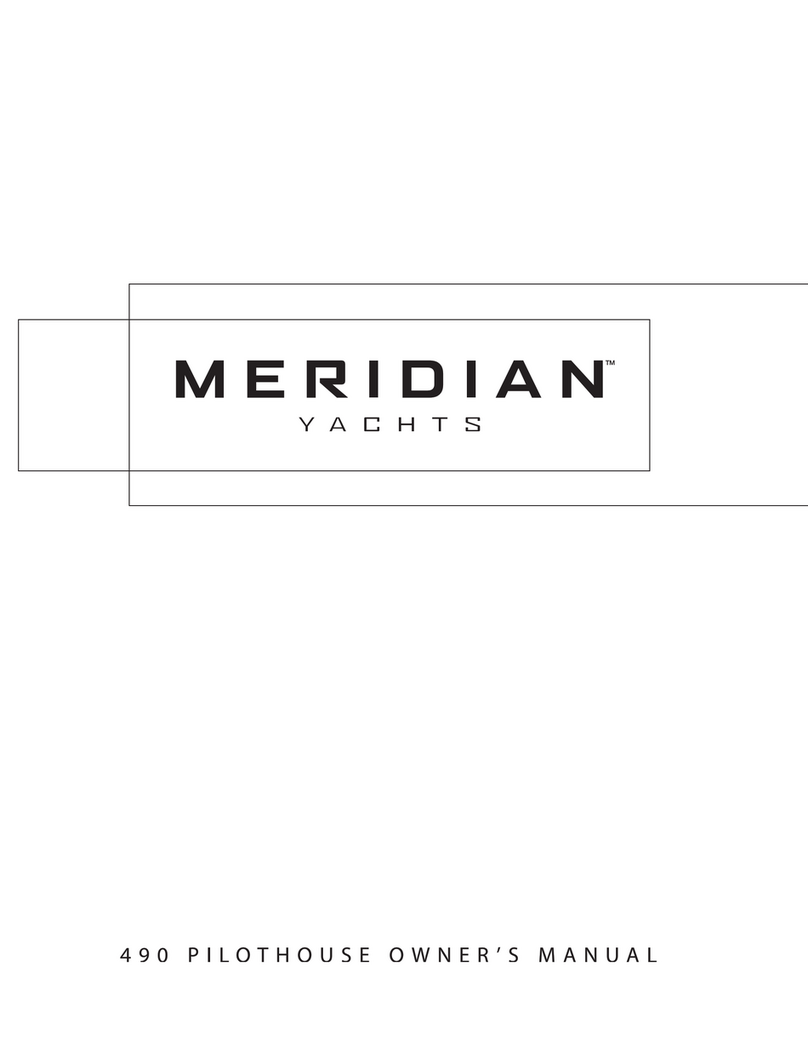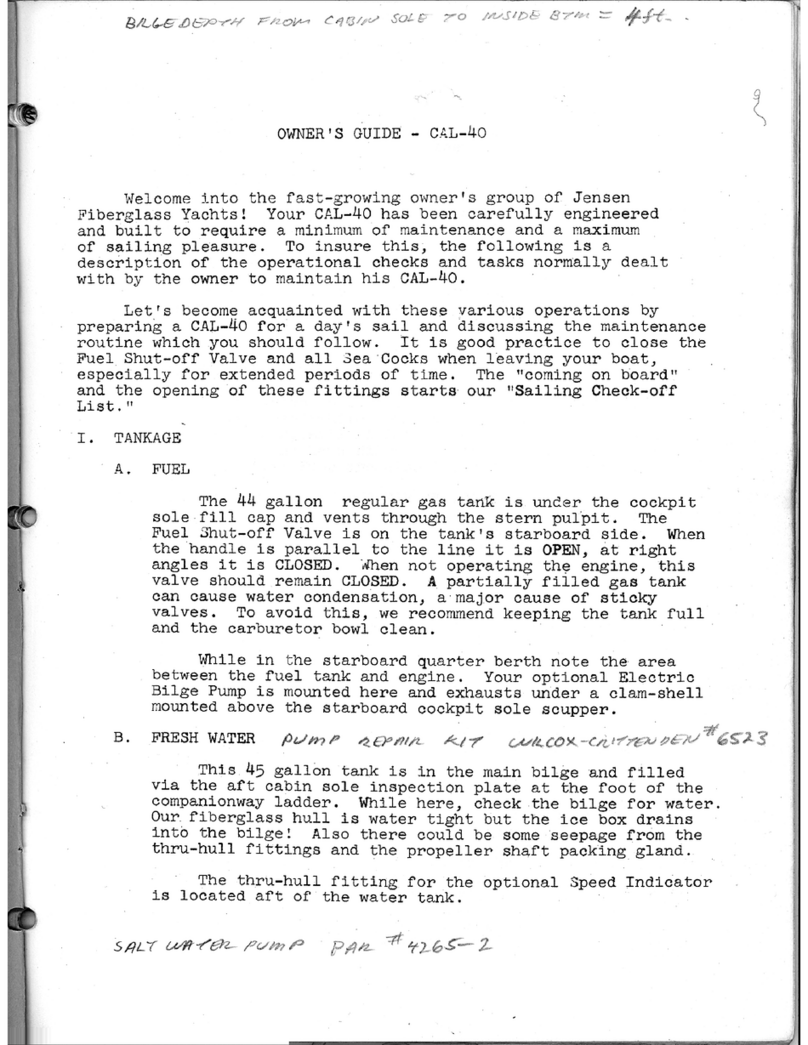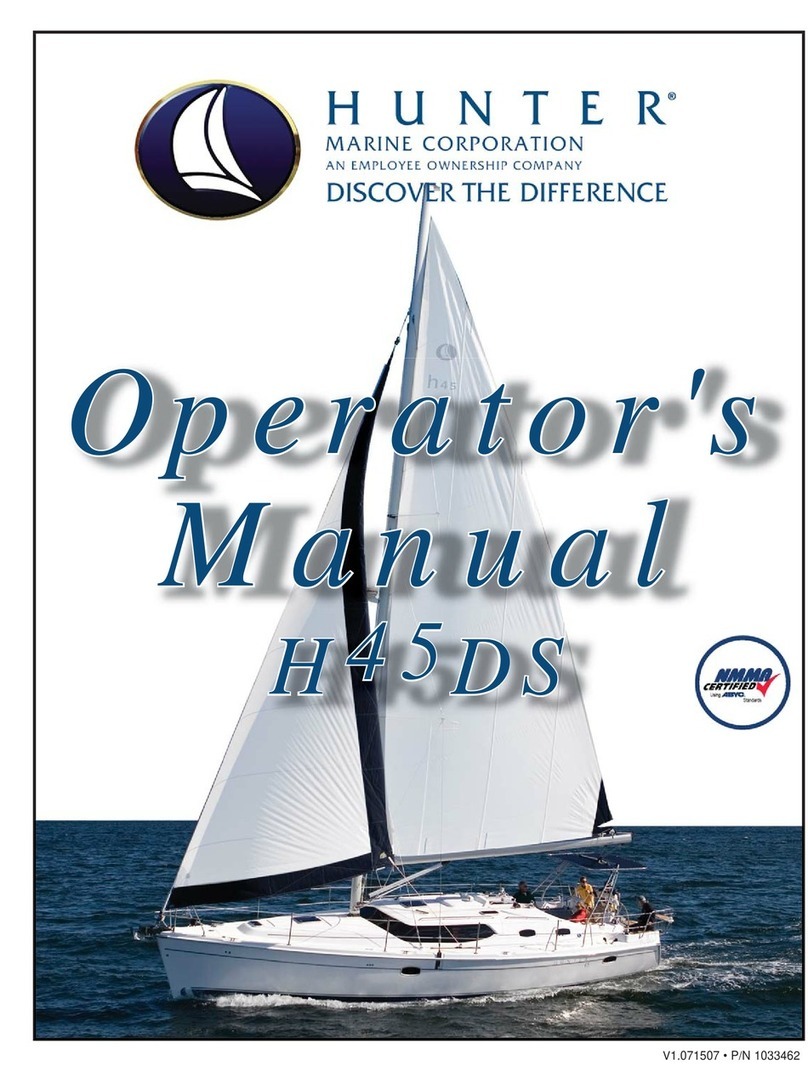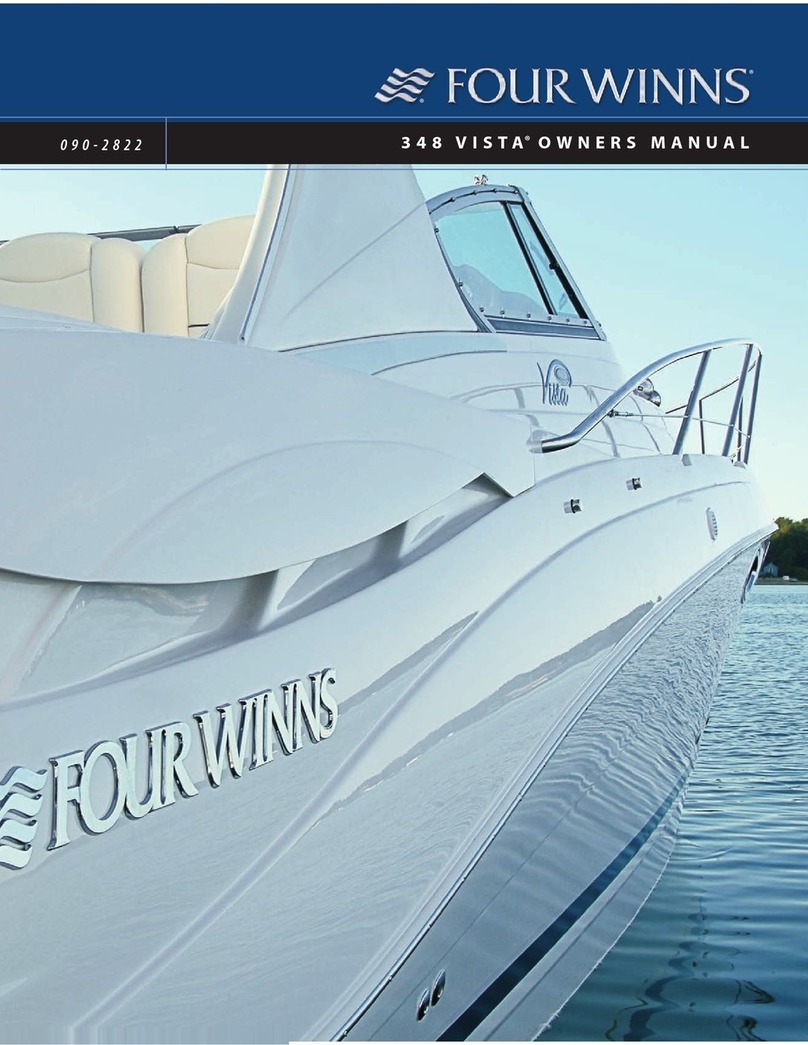GEKKO GTO 22 User manual

Section 1- Welcome To Gekko TOP
Section 2 - General Safety Precautions
Driver’s Responsibilities
Warning Plates and Labels
Boatman’s Check List
Check Before Running Engine:
Check While Engine is Running
Gasoline Vapor Precautions
Section 3 - Boating Safety
Coast Guard Regulations
Maximum Capacities
Safety Equipment
Section 4- Watersports Safety
Ski Pylon Extensions
Section 5- Boating Rules
Basic Boating Rules
Encountering Other Vessels
Buoy Types
Section 6- Operating Information
Before Launching
Install Bilge T Plug
Install Rear Drain Plug
Water Scoop
Fueling and Fuel Precautions
Section 7- Starting & Operation
Throttle/ Transmission Controls
Pre-starting Procedure
How To Start An Electronic Fuel Injection (EFI) Engine
How To Start A Carbureted Engine
If Carbureted Engine Does Not Start
If Carbureted Engine Floods
Break In Period
Section 8- GT Series Instrument Panel & Controls
GT Series Dashboard (GTX 22, GTR 22, and GTO 22 models)
Operating at Night time
GT Dash Gauges

Engine Hours
Section 9- GT Cockpit, Equipment Features & Options
Direct Drive Ski Pylon
Direct Drive Motor Box
Mirror
Cell phone/ sunglasses Pouch
In Deck Cooler
Rear Trunk
Glove Box
Net Pockets
Sun Deck
Tilt Steering
Rear Tow Eye
Propeller
Optional Dash Equipment
Gekko Pilot System
Perfect Pass
Section 10- REVO Series Instrument Panel & Controls
REVO Dash Board- REVO 6.7, REVO 6.7i, REVO 7.1
Silicon Touch Pads
Ballast Systems & Controls
Night Time Operation
REVO Dash Gauges
Engine Hours
Circuit Breaker Panel
Section 11- REVO Cockpit, Equipment Features & Options
Power Point/ DC Outlet
Mirror
Tilt Steering
Driver’s Seat & Seat Adjustment
V-Drive Tow Pylon
REVO Lighting
Lifting Eyes
Ski Platform
Ski Storage
Sun Deck
Propeller
Wake Plate- REVO 7.1 Only
Walk-Thru Windshield
Glove Box
Beverage Holders
Net Pockets
Snap-in Carpet
Optional Dash Equipment

Gekko Pilot System
Perfect Pass
Section 12- Service & Maintenance
Cooling System
Body Lubrication
Fuel Filter-Water Separator
Oil Level Check
Oil-Fill Spout
Engine Oil and Filter
Direct Drive Transmission Level Check
Change Frequency
V drive gear box
V-Drive Fluid Check
Maintaining Fluid Levels
Coupler bolts
Shaft Log Packing Nut
Bilge Inspection Plate
Battery Cable Installation & Precautions
Section 13- Cleaning, Care & Storage
Fiberglass Care
Foreign deposits
Washing Your Boat
Custom Gekko Boat Cover
Rub Rail Care
Windshield Care
Upholstery Care
Boat Hull Protection
Section 14- Winterization & Dry Storage
Section 15- Technical Information
Hoisting
Identification Number
Battery
Boat Specifications
Plexus Construction
Programming The REVO Keyless Ignition
Bazooka Internal Ballast System Operation
Mercruiser Engine and Data
PCM Engine Data
Ultra Low Emissions
PME Box (REVO Electrical Codes)
Section 16- Trailer and Towing
The Trailer

Connecting the Trailer to Your Vehicle
Five-Pin Connector
Safety Chains
Emergency Brake Pin
Launching and Loading Your Boat
Unloading Procedure
Loading Procedure
Securing the Boat to the Trailer
Trailer Alignment
Prolong Trailer Life
Bearing Buddy
Lug Nuts
Drying Your Boat After Loading
Section 17- Gekko’s Owners Information
Gekko Warranty
Gekko Owners Registration Form
Owners Responsibility
Dealers Responsibility
Gekko, the Gekko Icon and company marks are registered trademarks of Gekko Sports.
This Owners Manual is
Copyrighted by
Gekko Sports and its contents may
not be reproduced in any form without written permission of
Gekko Sports

Gekko Sports Owners Manual
Section 1- Welcome To Gekko TOP
Congratulations and thank you for buying a Gekko! Recognized as a World Class
performer, your new Gekko represents the industry’s most innovative thinking and is
designed to impress the most demanding water sports enthusiast.
With the best rough water ride, near 50 mph top end and world class wakes, the GTO
22 is the worlds best tracking tow boat. Featuring the same hull as the GTO 22, the
GTR 22 is AWSA approved for record capable events. Just introduced, the new REVO
series are the industry’s most advanced tow boats with aerospace architecture, deep
forward keels for superior ride, world class performance and a striking dash with soft
touch silicone switch pads, keyless ignition, automotive wiring harness and gauges
with lifetime warranties. Gekko’s hull design is so innovative that Gekko is the only
towboat manufacturer with a copyright from the US copyright office.
In other words, your new Gekko should be the source of exceptional water sports fun
for years to come.
Use this manual as an important reference and as a familiarization tool to become
more knowledgeable about your Gekko boat, boat operation, safe boating practices,
boating rules, maintenance, and other important aspects regarding the use of your
boat.
Before getting to the water it’s crucial that you understand the rules of the road when
it comes to boating safety and have a thorough awareness about your boat and its
operation. Your dealer is also a valuable source of information about your boat and
the necessary requirements for a safe and fun water sports experience.

The latest product information available at the time of publication provided the basis
for all data, pictures, information, and specifications featured in this manual.
Information about numerous Gekko models is presented. Since standard and optional
equipment varies from model to model
some information contained in this manual
may not apply to your boat
. At its sole discretion, Gekko Sports reserves the right to
change model line specifications, designs, equipment, color schemes at any time
without notice and without incurring obligation.
To help you avoid potential situations that could result in injury and/ or death you’ll
find certain CAUTION, WARNING, and DANGER advisories throughout this manual.
By becoming conscious of these hazards you’ll be better prepared to avert
circumstances that endanger you, your passengers and other boaters.
Safety, Maintenance, Operation TOP
YOUR COMPLETE KNOWLEDGE OF ALL SAFETY INFORMATION IS CRUCIAL.
While designed to deliver consistent, trouble-free operation your boat still requires
certain maintenance at regular intervals. To maximize the life of your boat a
maintenance schedule is included. If you are not familiar with or unable to perform
required service, your dealer is equipped to perform all dimensions of mechanical
service and share knowledge about your Gekko. The lifespan of your boat, your on-
water safety and satisfaction is a direct function of how you operate and maintain
your boat. Learning about the features, controls and operating instructions serves as
the basis for safe, fun and painless on-water experience. Taking the time to
completely understand the information in this manual will enhance your enjoyment
of your Gekko and prevent dangerous situations. Keep in mind that a lack of common
sense, boating ignorance and insufficient product knowledge can endanger lives.
These advisories call attention to increasing degrees of threatening hazards:
IMPORTANT
Be mindful of information important to the safe operation of your boat.
CAUTION !
Be mindful of unsafe practices and possible dangers that could result in injury.
WARNING !
Be mindful of unsafe practices and possible dangers that could result in serious injury
or death.
DANGER !
Be mindful of unsafe practices and possible dangers that will result in serious injury or
death if precautions are not taken.

These advisories are not exhaustive nor do they address the myriad of potentially
dangerous and life threatening scenarios that exist. You should also make your
passengers aware of all safety concerns and operations information. Further, you
must be confident that your decision to use any equipment, parts or tools, perform
procedures, practices or methods, that are not specifically recommended by Gekko
Sports will not damage your boat, is safe and does not endanger you, others and the
safe operation of your boat
IMPORTANT
THERE IS NO SUBSTITUTE FOR COMMON SENSE WHEN OPERATING, SERVICING
OR REPAIRING YOUR BOAT!
Section 2 - General Safety Precautions TOP
Driver’s Responsibilities
Your failure to observe safety precautions can result in severe personal injury or death
to you and to others. Taking unnecessary chances and ignoring precautions may lead
to injury or death!
Recognizing potentially dangerous situations is the first step to avoiding accidents.
Following basic safety instructions and precautions can reduce boating accidents. An
informed boat owner is a safer operator.
WARNING !
Severe injury or death to you and/or others may result from your failure to react to
these warnings.
• Improper operation is extremely dangerous. Operators must read and understand all
operating manuals supplied with the boat before operation.
• On-board equipment must always conform to the governing federal, state, and local
regulations.
• An adult should accompany small children in the bow of the boat at all times.
• While the boat is underway, no person should be riding forward of the windshield.
• Never stand or allow passengers to stand while the boat is moving, you or others
may be thrown from the boat.
• Never operate the boat while under the influence of alcohol or other drugs.

• Gasoline vapors can explode. Before starting engine, open engine box, check engine
compartment for gasoline vapors, and operate blower for at least 4 minutes. Run
blower below cruising speed.
• Leaking fuel is a fire and explosion hazard. Inspect system regularly. Examine fuel
tanks for leaks or corrosion at least annually.
• Never override or modify components of the fuel system in any way except for
maintenance by qualified personnel. Tampering with fuel components may cause a
hazardous condition
• Never allow any type of spark or open flame on board. It may result in fire or
explosion.
DANGER !
To avoid serious personal injury, DO NOT be on or about the swim platform while
engine is running and keep away from transom of boat while engine is running.
To avoid serious personal injury, DO NOT operate engine while anyone is on or about
the swim platform or in the water neat the boat.
Warning Plates and Labels TOP
Read and note ALL warning plates and labels from bow to stern that appear on the
boat and trailer including these shown below.

Boatman’s Check List TOP
•Drain Plugs (Securely in place?)
•Life Saving Devices (One for every person on board?)
•Steering System (Working smoothly sand properly?)

•Fuel System (Adequate fuel? Leaks? Fumes?)
•Battery (Fully charged? Cable terminals clean and tight?)
•Engine (In neutral?)
•Capacity Plate (Are you overloaded or overpowered?)
•Weather Conditions (Safe to go out?)
•Electrical Equipment (Lights, horn, pump, etc?)
•Emergency Gear (Fire extinguisher, bailer, paddle, anchor & line, signaling
device, tool kit, etc?)
•Bilge Pump (Working properly?)
Check Before Running Engine: TOP
•Check Engine Oil Level
•Check Transmission Lubricant Level
•Are the Engine Drain Plugs in?
•Leakage (Fuel and Water Lines and Connections)
CAUTION !
DO NOT operate engine without cooling water flowing through water pump,
otherwise pump will sustain damage and subsequent engine damage may result.
Check While Engine is Running TOP
•Oil Pressure: Refer to Engine Owner’s Manual
•Water Temperature: 160 degrees to 180 degrees for raw water systems (water is
not recirculated).
•Idle RPM (550-600) in gear
•Maximum forward RPM: See Engine Manual
•Shifting linkage (Forward, Neutral and Reverse)
Gasoline Vapor Precautions
WARNING !
It is very important to check for fuel spillage or leaks prior to each use of your boat.
•• Check engine compartment for gasoline vapors.
•• Operate blower for 4 minutes.
•• Always operate blower below cruising speed.
Section 3- Boating Safety TOP
There are multiple sources for safety information and training courses. In addition to
information in this manual you are encouraged to inquire with the following agencies
for more information to insure a safe and enjoyable boating experience:
American Red Cross, National HQ

17th & D Street NW
Washington, DC 20006
(202) 639-3686
www.redcross.org
Boat Owners Association of the United States (Boat/US)
880 South Pickett Street
Alexandria, VA 22304
(703) 823-9550
www.boatus.com
National Safe Boating Council
2550 M Street NW, Suite 425
Washington, DC 20037
(202) 296-4588
www.safeboatingcouncil.org
On-Line Basic Boating Safety Course available at:
www.boatsafe.com
USA Waterski
799 Overlook Drive
Winter Haven, FL 33884
(941) 324-4341
www.usawaterski.org
U.S. Coast Guard Auxiliary Commandant (G-NAB)
2100 Second Street SW
Washington, DC 20593-0001
(800) 336-2628
www.cgaux.org
U.S. Power Squadron
www.usps.org
Coast Guard Regulations TOP
The United States Coast Guard boating regulations prescribe minimum standards of
safety to be met and maintained by all watercraft. It is necessary that your boat
remain in compliance with these regulations.
The staff at Gekko Sports recommends that all boat operators complete a Coast Guard
approved boating safety course.
Maximum Capacities TOP

In compliance with United States Coast Guard Regulations, Gekko Boats meet or
exceed all safety standards designed for recreational boats. To ensure safe handling
and performance, each Gekko boat displays a maximum capacity sticker (see sample),
stating the maximum passenger weight load allowable.
IMPORTANT
Refer to the Maximum Capacity Sticker in your boat for allowable loading.
Safety Equipment TOP
While Federal regulation mandate certain safety equipment to be on-boat at all times,
sensible boaters carry additional equipment to be well prepared in the event of an
emergency.
Factory installed equipment that meets federally required safety equipment for inland
waters (Class 1, 16’-to-26’) includes:
• USCG-approved spark-less power blower for bilge and motor box ventilation
• USCG-approved Marine Flame Arrestor
• USCG-approved inland lighting
• ABYC-approved Electric Horn sound warning device
You are responsible for compliance with local and state laws as regulations vary from
state to state and from Federal to local waterways. Check with the local authorities
for specific information.

You are required by Federal law to have readily accessible on-board:
• A Personal Flotation Device (PDF) for each person
• One throwable Type IV PFD
• A Coast Guard Approved fire extinguisher
Here’s a basic list of recommended additional equipment:
• First aid kit and manual
• Spare prop and puller
• Spare trailer tire
• Duct tape
• Fresh drinking water
• Tool kit
• Sunscreen
• Swim mask
• Headwear for sun protection
• Local navigation charts
• Mooring lines and fenders
• Anchor with sufficient anchor line
• Manual bailing device for removing water
• Combination oar/boat hook
• A day-and-night visual distress signal
• A tool kit
• Airway breathing tube
• Waterproof flashlight
• Knife
• Extra engine oil
• A portable AM/FM radio or a weather radio
Section 4- Watersports Safety TOP
If you are new to water skiing, wakeboarding or any other towed water sports
activity, seek certified training before starting. You will find it especially helpful to join
a local ski club, USA Waterski, or similar organization when possible. Skiers are
obligated to be as aware of the fundamental safety rules as well as the boat operator.
The majority of water skiing, wakeboarding and other towed water sports injuries are
the result of impacts with other objects, so always look where you are going and be
aware of what is going on around you.
WARNING !

Severe injury or death to you and/or others may result from your failure to react to
these warnings.
• Every skier must always wear a USCG-approved personal flotation device.
• Maintain a distance of at least 100 feet from all other objects, including other boats,
piers, rafts, mooring and navigational buoys, pilings, abutments, or any other items.
• Always have an experienced driver and observer in the boat when skiing.
• Never put your arm, head, or any other part of your body through the handle-bridle
of the ski line nor wrap the line around any part of the body at any time.
• Never ski at night, or directly in front of other boats.
• Never jump from a boat that is moving at any speed, nor enter or exit the water
when the engine is running.
• Make sure that everyone knows and uses approved skiing hand signals and common
skiing courtesy.
• Towers are designed to pull a single (1) individual. DO NOT climb or sit on the
Tower. Rope may loop on inverted tricks. DO NOT sit behind the pulling point of the
Tower.
Ski Pylon Extensions/ Towers TOP
The use of any ski pylon extension, vertical or horizontal, is not recommended by
Gekko Sports on any Gekko product. Be aware that the use of pylon extensions could
create excessive stress on your boat and subjectively cause damages not covered by
the warranty.
CAUTION !
Failure to adhere to these precautions may result in severe injury or death to you
and/or others.
• Ski Pylons are not designed for vertical extensions. Modifications to the Pylon or its
mountings may result in damage to the boat and injury to the user.
• Boats equipped with a Tower may strike low objects. Check clearance height around
docks, shore, overhanging objects, bridges and power lines.
• DO NOT pull past 45 degrees of the centerline of the boat. Failure to follow this rule
could result in the boat capsizing.

• Towers and pylons are designed to pull a single individual only.
Section 5- Boating Rules TOP
Basic Boating Rules
You should be aware of these rules and follow them whenever you encounter another
vessel on the water.
The rules presented in this manual are condensed and have been provided as a
convenience only. Consult your local U.S. Coast Guard Auxiliary (USCGA) or
Department of Motor Vehicles (DMV) for a complete set of rules governing the
waters in which you will be using your boat. If you plan to travel, even for a short trip,
you would be well served to contact the regional USCGA or DMV in the area where
you will be boating.
Review and understand all local and state laws.
Any time two vessels on the water meet one another, only one vessel has the right-of-
way. It is called the
stand-on vessel
. The vessel which does NOT have the right-of-way,
is called the
give-way
or
burdened
vessel.
These rules determine which vessel has the right-of-way, and accordingly, what each
vessel should do.
The vessel with the right-of-way has the duty to continue its course and speed, except
to avoid an immediate collision. When you maintain your direction and speed, the
other vessel will be able to determine how best to avoid you.
The vessel which does not have the right-of-way, has the duty to take positive and
timely action to stay out of the way of the
stand-o
n vessel. Normally, the
give-way
vessel should not cross in front of the
stand-on
vessel. Slow down or change directions
briefly and pass behind the other vessel. You should always move in such a say that
the
stand-on
operator can see what you are doing.
This rule is called Rule 2 in the International Rules and says, “
In obeying and
construing these rules due regard shall be had to all dangers of navigation and
collision, and to any special circumstances, which may render a departure from the
above rules necessary in order to avoid immediate danger.
”
Encountering Other Vessels TOP
There are three main situations in which you may encounter other vessels and you
must observe the Steering Rules in order to avoid a collision. These are:

• Meeting (you are approaching another vessel head-on)
• Crossing (you are traveling across the other vessel’s path)
• Overtaking (you are passing or being passed by another vessel)
Using the following illustration in which you are the boat in the center, you should
give right-of-way to all vessels shown in the red area. In this instance, you are the
give-way vessel. All vessels to your port side and aft must yield to you as you are the
stand-on
vessel. Both you and a head-on meeting vessel must alter course to avoid
each other.
If you are meeting another power vessel head-on and you are close enough to run the
risk of collision, neither of you has the right-of-way. Both of you should alter course
to avoid an accident. You should keep the other vessel on your port (left) side. This
rule doesn’t apply if both of you can clear each other by continuing your set course
and speed.

When two power-driven vessels are crossing each other’s path close enough to run the
risk of collision, the vessel that views the crossing vessel to the starboard (right) side
must give-way.
If the other vessel is to the port (left) side, maintain your course and direction,
provided the other vessel gives you the right-of-way as it should.
If you are passing another vessel, you are the give-way vessel. This means that the
other vessel is expected to maintain its course and speed. You must stay out of its way
as you clear it, altering course and speed as necessary.
Conversely, if you are being passed by another vessel, you should maintain your speed
and direction so that the other vessel can steer itself around you.

There are three other rules to always remember when driving your boat around other
vessels.
When navigating in narrow channels, you should keep to the right when it is safe and
practical to do so. If the operator of a power-driven vessel is preparing to go around a
bend that may obstruct the view of other water vessels, the operator should sound a
prolonged blast on the whistle or horn--four to six seconds.
If another vessel is around the bend, it too should sound the whistle or horn. Even if
no reply is heard, however, the vessel should still proceed around the bend with
caution.
If you navigate these types of waters, you should carry a portable air horn, which are
available from local marine supply stores.
All vessels that are fishing with nets, lines or trawls are considered under International
Rules to be fishing vessels. Boats with trolling lines are not considered fishing vessels.
Fishing vessels have the right-of-way, regardless of position. These vessels, however,
cannot impede the passage of other vessels in narrow channels.
Sailing vessels should normally be given the right-of-way. The exceptions to this are:
1.When the sailing vessel is overtaking the power-driven vessel, the power-driven
vessel has the right-of-way.
2. Sailing vessels should keep clear of any fishing vessel.
3. In a narrow channel, a sailing vessel should not hamper the safe passage of a power-
driven vessel, which can navigate only in such a channel.
The waters of the United States are marked for safe navigation by the lateral system
of bouyage. The markers and buoys you will encounter nave an arrangement of
shapes, colors, numbers and lights to show which side of the buoy a boater should
pass when navigation in a particular direction.
The markings on these buoys are oriented from the perspective of being entered from
seaward while the boater is going towards the port. This means that red buoys are
passed on the starboard (right) side when proceeding from open water into port, and
black buoys are to port (left) side. When navigating out of port, your position to the
buoys should be reversed: red buoys to port and black buoys to starboard.
Many boating bodies of water are entirely within the boundaries of a single state. The
Uniform State Waterway Marking Systems has been devised for these waters. This
system uses buoys and signs with distinctive shapes and colors to show regulatory or
advisory information.
These markers are white with black letters and orange borders. The information
signifies speed zones, restricted areas, danger areas and general information.

Remember: Markings may vary by geographic location. Always consult local boating
authorities before driving your boat in unfamiliar waters.
NOTES:

Buoy Types TOP
NOTES:
Table of contents
Other GEKKO Boat manuals

